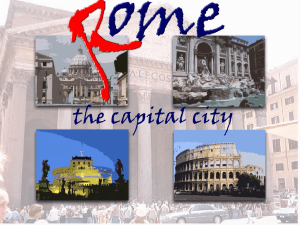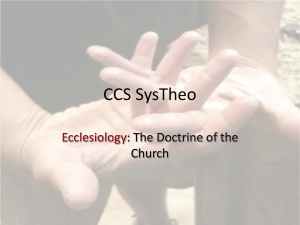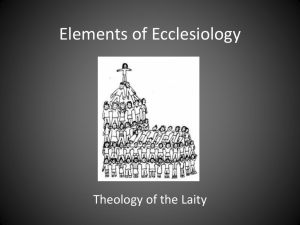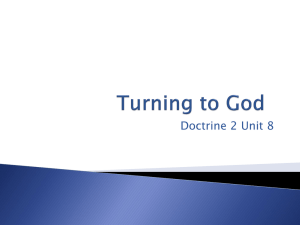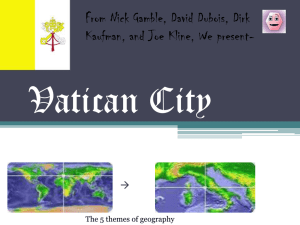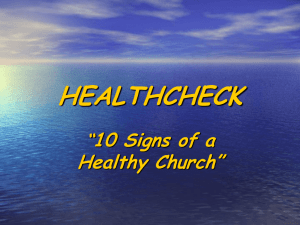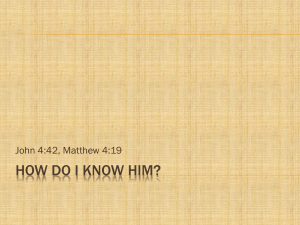ELM 2003: Ecclesiology and Ecumenism
advertisement
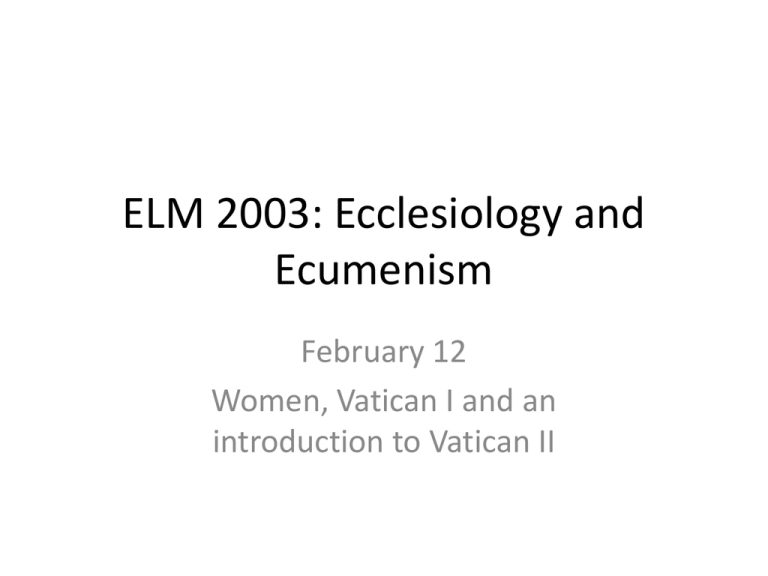
ELM 2003: Ecclesiology and Ecumenism February 12 Women, Vatican I and an introduction to Vatican II Review of Last Week’s Class • Nicaea • Period between Nicaea and Chalcedon • Chalcedon • Chalcedon to Trent Constantinople II and III, Nicaea II and Constantinople IV Great Schism, lay investiture, Western Schism and conciliarism Trent: Attempt to re-vivify ossified Church structures Key points for Canons from Nicaea • Discipline for the life of clerics, incardination into a particular church • Regulations to safeguard communion among bishops, especially “bishops of bishops” • One city, one bishop • Synods • Penitential discipline Key points for Chalcedon • It is Peter who has spoken through Leo • Regulations for clerical life: renewed prohibitions against vagante clerics, simony, excluded from the military and business • Metropolitans and Synods • Deaconesses • Canon 28 and the New Rome Key Points on Trent • Book recommendation: H. Jedin, History of the Church: Reformation and CounterReformation, vol. 5. • Attempted to revive interest in the Bible • Formulated residence requirements for bishops and priests with the cure of souls • Annulled laws that limited a bishop’s authority over his diocese Key Points on Trent (cont.) • Attempted to re-establish discipline for clergy, especially secular clergy (knowledge of Latin, clerical dress, concubinage, minimum moral qualifications) • Founded seminary system for secular clergy • Ensured that there were benefices for those ordained • Reminded pastors of the need for instruction before receiving sacraments • Banned dueling Today’s class • A quick look at women’s role in Ecclesiology from 451-1563 • An overview of Ecclesiology from 1563-1869 (looking also at the Protestant ecclesiology that influenced our country’s founding) • Vatican I • A sketch of the Church from 1870 to 1962 Highlights for Women and Ecclesiology • In the New Testament it is clear that women played a key role in the life of the early Church (including the formal roles of deaconess and widows) • From the patristic age to Trent, special roles for women in the Church gravitate toward monastic life • After Trent, women religious began engaging in more active apostolates (lay ministry) Women and Ecclesiology • The monastic ecclesiology of the early medieval Church in Ireland, Scotland and Wales gave jurisdiction to the Abbot or Abbess rather than the bishop • The famous case of Brigit of Kildaire (451-525) • Celtic missionaries brought this custom to the continent • Note the distinction, still present in Canon Law, between order and jurisdiction Women and Ecclesiology • Byzantine Empresses St. Pulcheria (398-453): took a vow of virginity, played a crucial role both at Ephesus and Chalcedon Irene (752-803): Regent during the resolution of Iconoclasm In Christendom females did occasionally exercise temporal rule Women and Ecclesiology (cont.) • St. Hildegard of Bingen (1098-1179) doctor of Church, abbess, mystic, preacher, theologian and composer; friend of Saint Bernard of Clairvaux, the Abbot Suger and correspondent with popes • St. Clare of Assisi (1194-1253) companion of Saint Francis, abbess, religious founder, promoted evangelical poverty in women’s religious life • Dominic first founded Dominican nuns to support the preaching ministry of the friars • St. Catherine of Siena (1347-1380) Dominican tertiary, doctor of the Church, mystic, advocate for return of the papacy to Rome Women and Ecclesiology (cont.) • St. Teresa of Jesus (1515-1582) Carmelite reformer of friars and nuns, mystic and doctor • St. Jane Frances de Chantal (1572-1641), coworker with Saint Francis de Sales and founder of the Visitation sisters and… • St. Louise de Marillac (1591-1660), co-worker with Saint Vincent de Paul and founder of the Daughters of Charity, pioneered active women’s religious life that took place outside of the cloister Highlights for Women and Ecclesiology • In the New Testament it is clear that women played a key role in the life of the early Church (including the formal roles of deaconess and widow) • From the patristic age to Trent, special roles for women in the Church gravitate toward monastic life • After Trent, women religious began engaging in more active apostolates (lay ministry) Overview of Ecclesiology from Trent to Vatican I • After Trent, Popes reformed the Roman Curia and sought to centralize authority and power structures in Rome • St. Robert Bellarmine (1542-1621) gives a good sense of the flavor of Tridentine ecclesiology: • “…according to our doctrine, the one and true Church is the assembly of men, bound together by the profession of the same Christian faith, and by the communion of the same sacraments, under the rule of legitimate pastors, and in particular of the one Vicar of Christ on earth, the Roman Pontiff…” • “…For the Church is an assembly of men, as visible and palpable as the assembly of the Roman people, or the Kingdom of France, or the Republic of the Venetians." Overview of Ecclesiology from Trent to Vatican I • The same is clear in Ignatius of Loyola’s Rules for Thinking with the Church: • The First Rule. With all judgment of our own put aside, we ought to keep our minds disposed and ready to be obedient in everything to the true Spouse of Christ our Lord, which is our Holy Mother, the hierarchical Church… • The Thirteenth Rule. To keep ourselves right in all things, we ought to hold fast to this principle: What I see as white, I will believe to be black if the hierarchical Church thus determines it. For we believe that between Christ our Lord, the Bridegroom, and the Church, his Spouse, there is the one same Spirit who governs and guides us for the salvation of our souls. For it is by the same Spirit and Lord of ours who gave the ten commandments that our holy Mother Church is guided and governed… Overview of Ecclesiology from Trent to Vatican I • During the 17th and 18th centuries, the Church faced dual challenges of Jansenism and the question of Church-state relations • The latter exploded with the French Revolution and the Enlightenment more broadly • The Church’s reaction to the French Revolution centered on attacking democracy and religious freedom • At the same time, this was an age of evangelization, particularly in Latin America Protestant Excurus: Key Points • There were tensions in Post-Catholic Britain between Puritans and Anglicans • These tensions bear on Ecclesiology: is the bishop the ultimate authority in the church or the individual believer interpreting the Bible? • Early American history leans heavily toward the latter due to Puritan and later Methodist influences A Protestant Excurus • When Henry VIII split with Rome in 1534, the tone of the Church of England remained largely Catholic. • Henry died in 1547; it was not until 1549 that English was used in the Eucharist and it was not until 1552 that recognizably Protestant forms of worship were adopted. • During the reign of Mary Tudor (1553-1558), Catholicism was restored in England and most of the people rejoiced (vide. Duffy, The Stripping of the Altars). • When Queen Mary died without an heir, the Protestant Elizabeth (1533-1603) became Queen of England. • The XXXIX Articles of Religion (1563) defined the faith of the Church of England and form the heart of the Elizabeth Settlement A Protestant Excurus (cont.) • In 1603, the Protestant James VI of Scotland succeeded Elizabeth as monarch of England, Wales and Ireland (The Puritan pilgrims landed in Plymouth in 1620). • In 1625, James was succeeded by his son Charles, who had married a Catholic. He was seen by many as taking the Church of England in a Catholic direction. • Charles had an exalted vision of the monarchy and could not get along with Parliament. This led to the English Civil War (1642-1646 ) in which Charles lost to the forces of Parliament and was eventually beheaded in 1649. A Protestant Excurus (cont.) • The Puritan Cromwell ruled England from 1649 until his death in 1658. • Charles II (r. 1660-1685) re-established bishops and the Prayer Book with the XXXIX Articles. He was received into the Church on his deathbed. • After Charles II’s death, his brother James II, a Catholic, became king. James advocated religious freedom and for this he was forced to flee to France. • He was succeed in 1688 by the Protestants William and Mary (Protestant daughter of James II), who in turn was succeeded by Queen Anne (1702-1714) • On Anne’s death, the German Protestant George of Hanover (17141727) succeeded her, although there were more 50 Catholics with a better claim The XXXIX Articles • VI: “Holy Scriptures containeth all things necessary to salvation: so that whatsoever is not read therein, nor may be proved thereby, is not to be required of any man, that it should be believed as an article of the faith, or be thought requisite or necessary to salvation…” • XIX: “The visible Church of Christ is a congregation of faithful men, in the which the pure word of God is preached and the sacraments be duly ministered according to Christ's ordinance in all those things that of necessity are requisite to the same. As the Church of Jerusalem, Alexandria, and Antioch have erred: so also the Church of Rome hath erred, not only in their living and manner of ceremonies, but also in matters of faith.” The XXXIX Articles (cont.) • XX: “The Church hath power to decree rites or ceremonies and authority in controversies of faith; and yet it is not lawful for the Church to ordain anything contrary to God's word written, neither may it so expound one place of Scripture, that it be repugnant to another. Wherefore, although the Church be a witness and a keeper of Holy Writ: yet, as it ought not to decree anything against the same, so besides the same ought it not to enforce anything to be believed for necessity of salvation.” • XXI: “General Councils may not be gathered together without the commandment and will of princes. And when they be gathered together, forasmuch as they be an assembly of men, whereof all be not governed with the Spirit and word of God, they may err and sometime have erred, even in things pertaining to God. Wherefore things ordained by them as necessary to salvation have neither strength nor authority, unless it may be declared that they be taken out of Holy Scripture.” The XXXIX Articles (cont.) • XXIII: “It is not lawful for any man to take upon him the office of public preaching or ministering the sacraments in the congregation, before he be lawfully called and sent to execute the same. And those we ought to judge lawfully called and sent, which be chosen and called to this work by men who have public authority given unto them in the congregation to call and send ministers into the Lord's vineyard.” • XXXIII: “That persons which by open denunciation of the Church is rightly cut off from the unity of the Church and excommunicated, ought to be taken of the whole multitude of the faithful as an heathen and publican, until he be openly reconciled by penance and received into the Church by a judge that hath authority thereto.” Religion in the American Colonies • New England: Puritan (Congregational with Calvinistic theology) with the exception of Rhode Island • Maryland: Catholic with freedom of religion in 1629, 1688 Catholics barred from voting, mix of religions • Other colonies: Mix of Anglican and other “dissenting” Christians. Some established Anglican churches • The Great Awakening (1730-1743) gave American Christianity a more evangelical flavor. • One of the four “Intolerable Acts” that lead to the Revolution was the Quebec Act, which granted religious freedom to Catholics outside the 13 colonies in British North America • The Revolutionary War (1776-1781) made Anglicanism very unpopular and the idea of a bishop unpopular • In 1790 John Carroll became the first Catholic bishop in the United States Protestant Excurus: Key Points • There were tensions in Post-Catholic Britain between Puritans and Anglicans • These tensions bear on Ecclesiology: is the bishop the ultimate authority in the church or the individual believer interpreting the Bible? • Early American history leans heavily toward the latter due to Puritan and later Methodist influences Key Points of Vatican I • The Church as a motive of credibility • The papacy Primacy of jurisdiction that is immediate The pope is infallible when speaking ex cathedra on faith and morals to be held by all the faithful Ecclesiology of Vatican I • Sess. 3, III, 10: “So that we could fulfill our duty of embracing the true faith and of persevering unwaveringly in it, God, through his only begotten Son, founded the Church, and he endowed his institution with clear notes to the end that she might be recognized by all as the guardian and teacher of the revealed word.” • 11: To the Catholic Church alone belong all those things, so many and so marvelous, which have been divinely ordained to make for the manifest credibility of the Christian faith. Ecclesiology of Vatican I (cont.) • 12: What is more, the Church herself by reason of her astonishing propagation, her outstanding holiness and her inexhaustible fertility in every kind of goodness, by her Catholic unity and her unconquerable stability, is a kind of great and perpetual motive of credibility and an incontrovertible evidence of her own divine mission. • 13: So it comes about that, like a standard lifted up for the nations, she both invites to herself those who have not yet believed, and likewise assures her sons and daughters that the faith they profess rests on the firmest of foundations. Ecclesiology of Vatican I (cont.) • 14: “…those who have accepted the faith under the guidance of the Church can never have any just cause for changing this faith or for calling it into question.” • Sess. 4, 2-3 Apostolic Succession • 4, 4 “In order, then, that the episcopal office should be one and undivided and that, by the union of the clergy, the whole multitude of believers should be held together in the unity of faith and communion, he set blessed Peter over the rest of the apostles and instituted in him the permanent principle of both unities and their visible foundation.” Ecclesiology of Vatican I (cont.) • 4, 6 “And since the gates of hell trying, if they can, to overthrow the Church, make their assault with a hatred that increases day by day against its divinely laid foundation, we judge it necessary, with the approbation of the Sacred Council, and for the protection, defense and growth of the Catholic flock, to propound the doctrine concerning the 1. institution, 2. permanence and 3. nature of the sacred and apostolic primacy, upon which the strength and coherence of the whole Church depends.” • 4, Ch. 1, 1 “We teach and declare that, according to the gospel evidence, a primacy of jurisdiction over the whole Church of God was immediately and directly promised to the blessed apostle Peter and conferred on him by Christ the lord.” Ecclesiology of Vatican I (cont.) • 4, Ch. 1, 2-3: Scripture supporting primacy • 4, Ch. 1, 4: “To this absolutely manifest teaching of the Sacred Scriptures, as it has always been understood by the Catholic Church, are clearly opposed the distorted opinions of those who misrepresent the form of government which Christ the lord established in his Church and deny that Peter, in preference to the rest of the apostles, taken singly or collectively, was endowed by Christ with a true and proper primacy of jurisdiction.” • 6: “Therefore, if anyone says that blessed Peter the apostle was not appointed by Christ the lord as prince of all the apostles and visible head of the whole Church militant; or that it was a primacy of honor only and not one of true and proper jurisdiction that he directly and immediately received from our lord Jesus Christ himself: let him be anathema.” Ecclesiology of Vatican I (cont.) • Ch. 2, 1: Petrine ministry does not end with Peter’s death • 2: Peter’s successors are the bishops of Rome • 3: Successors of Peter receive his rock-like strength • 4: “For this reason it has always been necessary for every Church--that is to say the faithful throughout the world--to be in agreement with the Roman Church because of its more effective leadership. In consequence of being joined, as members to head, with that see, from which the rights of sacred communion flow to all, they will grow together into the structure of a single body.” Ecclesiology of Vatican I (cont.) • 5 “Therefore, if anyone says that it is not by the institution of Christ the lord himself (that is to say, by divine law) that blessed Peter should have perpetual successors in the primacy over the whole Church; or that the Roman Pontiff is not the successor of blessed Peter in this primacy: let him be anathema.” • Ch. 3, 1 “…we promulgate anew the definition of the ecumenical Council of Florence, which must be believed by all faithful Christians, namely that the Apostolic See and the Roman Pontiff hold a world-wide primacy, and that the Roman Pontiff is the successor of blessed Peter, the prince of the apostles, true vicar of Christ, head of the whole Church and father and teacher of all Christian people. To him, in blessed Peter, full power has been given by our lord Jesus Christ to tend, rule and govern the universal Church.” Ecclesiology of Vatican I (cont.) • 2, “Wherefore we teach and declare that, by divine ordinance, the Roman Church possesses a preeminence of ordinary power over every other Church, • and that this jurisdictional power of the Roman Pontiff is both episcopal and immediate. Both clergy and faithful, of whatever rite and dignity, both singly and collectively, are bound to submit to this power by the duty of hierarchical subordination and true obedience, • and this not only in matters concerning faith and morals, but also in those which regard the discipline and government of the Church throughout the world.” Ecclesiology of Vatican I (cont.) • 5: “This power of the Supreme Pontiff by no means detracts from that ordinary and immediate power of episcopal jurisdiction, by which bishops, who have succeeded to the place of the apostles by appointment of the Holy Spirit, tend and govern individually the particular flocks which have been assigned to them… • On the contrary, this power of theirs is asserted, supported and defended by the Supreme and Universal Pastor; for St. Gregory the Great says: "My honor is the honor of the whole Church. My honor is the steadfast strength of my brethren. Then do I receive true honor, when it is denied to none of those to whom honor is due." Ecclesiology of Vatican I (cont.) • 8: An appeal to an ecumenical council against a Pope is impossible • 9: “So, then, if anyone says that the Roman Pontiff has merely an office of supervision and guidance, and not the full and supreme power of jurisdiction over the whole Church, • and this not only in matters of faith and morals, but also in those which concern the discipline and government of the Church dispersed throughout the whole world; • or that he has only the principal part, but not the absolute fullness, of this supreme power; or that this power of his is not ordinary and immediate both over all and each of the Churches and over all and each of the pastors and faithful: let him be anathema.” Ecclesiology of Vatican I (cont.) • Ch. 4, 1: Apostolic authority includes teaching authority • 2: References to Constantinople IV, Lyons II and Florence as regards Papal Primacy • 3: “To satisfy this pastoral office, our predecessors strove unwearyingly that the saving teaching of Christ should be spread among all the peoples of the world; and with equal care they made sure that it should be kept pure and uncontaminated wherever it was received.” Ecclesiology of Vatican I (cont.) • 4: “It was for this reason that the bishops of the whole world, sometimes individually, sometimes gathered in synods, according to the long established custom of the Churches and the pattern of ancient usage referred to this Apostolic See those dangers especially which arose in matters concerning the faith. This was to ensure that any damage suffered by the faith should be repaired in that place above all where the faith can know no failing.” • 5: “The Roman pontiffs, too, as the circumstances of the time or the state of affairs suggested, sometimes by summoning ecumenical councils or consulting the opinion of the Churches scattered throughout the world, sometimes by special synods, sometimes by taking advantage of other useful means afforded by divine providence, defined as doctrines to be held those things which, by God's help, they knew to be in keeping with Sacred Scripture and the apostolic traditions. Ecclesiology of Vatican I (cont.) • 6: “For the Holy Spirit was promised to the successors of Peter not so that they might, by his revelation, make known some new doctrine, but that, by his assistance, they might religiously guard and faithfully expound the revelation or deposit of faith transmitted by the apostles….” • 7: Why the papacy? “…so that the whole flock of Christ might be kept away by them from the poisonous food of error and be nourished with the sustenance of heavenly doctrine. Thus the tendency to schism is removed and the whole Church is preserved in unity, and, resting on its foundation, can stand firm against the gates of hell.” Ecclesiology of Vatican I (cont.) • 9: “we teach and define as a divinely revealed dogma that when the Roman Pontiff speaks EX CATHEDRA, that is, when, in the exercise of his office as shepherd and teacher of all Christians, • in virtue of his supreme apostolic authority, he defines a doctrine concerning faith or morals to be held by the whole Church, • he possesses, by the divine assistance promised to him in blessed Peter, that infallibility which the divine Redeemer willed his Church to enjoy in defining doctrine concerning faith or morals. • Therefore, such definitions of the Roman Pontiff are of themselves, and not by the consent of the Church, irreformable. Key Points of Vatican I • The Church as a motive of credibility • The papacy Primacy of jurisdiction that is immediate The pope is infallible when speaking ex cathedra on faith and morals to be held by all the faithful Why a need for a new council? • With papal infallibility defined, some felt there would never be the need for another council • Vatican II was called to face a pastoral crisis that came after two world wars and during the Cold War • Moreover Vatican I had never finished its work! • The council sought to proclaim the faith more effectively to a modern world that was finding it increasingly irrelevant • The Liturgical Constitution provides a good example: (1) make rites more comprehensible (2) increase in the of the vernacular (3) facilitate deeper participation (4) present the faith more organically
